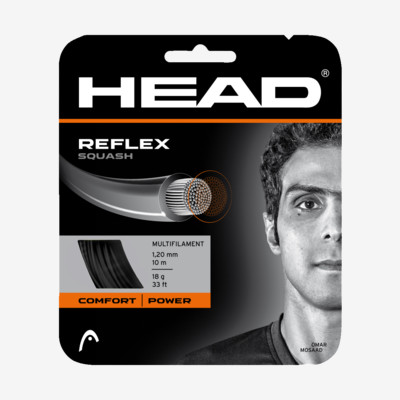
Stringing your Squash Racket
Mono-Filament Synthetic:
Mono-filaments are the cheapest and most widely used strings but while the least susceptible to tension loss they vary in durability as well as performance. Generally Mono-filaments have lower elasticity and generate less power. They can also cause the ball to ‘skid’ thus giving less control.
Most new rackets are pre-strung with mono-filament strings because the strings themselves are cheaper.
Thin or Thick String:
The key question to ask here is: Should it be a thinner gauge for maximum performance or a thicker one for greater durability?
Then you must decide whether to go for higher or lower tension stringing. The important factor here is whether you need more power or better control?
Even if you’ve just invested in a new racket with a dense string pattern and decide you want more power from it, you can alter its playing characteristics by having it re-strung with finer gauge strings at a lower tension.
It is important to remember that when you buy a squash racket it´s normally well strung and that you will be able to play efficiently with it. However as you progress as a player you will develop preferences and discover that by choosing certain strings you can improve the playing characteristics of the racket.
Thinner strings do provide more power while thicker strings give more control and durability. Thinner string is bouncier. When you hit the ball the string stretches back then suddenly springs forward producing a trampoline effect thus generating more power.
To sum up: thinner strings traditionally allow for more stretch and so provide more power.
But while thin strings are seen as livelier with the advances in material technologies and also innovative string construction, stringing tension and string material ie: the type of filament that the string is made from, play a much bigger role in generating power than gauge alone.
How to Choose the Right Tension:
When you re-string your racket you also need to choose the tension.
Stringing tension also utilises the trampoline effect to enhance the racket’s power to a larger degree than gauge. By stringing your racket at a looser tension you allow for more stretch on impact and increase the power with which the ball is propelled from the face of the racket.
In general, the tighter the strings the simpler it is to control the ball while the looser the strings the easier it is to generate a lot of power for your shots.
With low tension the strings are more flexible and can move up and down like a trampoline, which in turn results in more ball acceleration.Most players prefer a tension of 11-13 kg which is also the factory tension for most rackets. It´s not too tight but not too loose either. If you don´t know what tension to choose or don´t have a preference, 11.5 kg is a safe choice.
Players looking for more power can choose 10.5-11 kg. For players new to squash it is advisable to gradually increase or decrease the tension until you discover what is your preference.
But for those who want more ball control, a slightly higher tension 12-13 kg may be best as tighter strings make it easier to play accurate shots.
One thing to remember is that it’s always a good idea to discuss your needs with a professional stringer who understands squash.
Can you use tennis strings for squash?
The simple answer is no.
Squash strings are made in three sizes: 16g, 18g and 20g (gauge).
20g (1,10mm) or 18g (1,20mm) strings will deliver more power, but less strength and durability, than a 16g (1,30mm).
As a rule of thumb you can remember: the more power and feel, the thinner the string – the more strength and durability the thicker the string should be.
Even thicker strings are intended for tennis or racquetball and cannot deliver adequate power when strung into the smaller head of a squash racket.
















